Welcome to Shinyanga, Tanzania, where you can find an abundance of unique birds in their natural habitat. From the majestic crowned crane to the colorful bee-eater, the diverse avian wildlife of Shinyanga is a sight to behold.
Whether you’re a birder, a nature enthusiast, or just looking for a unique experience, you’ll find something to love in Shinyanga’s avian population.
From the wetlands of the Manyara National Park to the savannahs of the Rift Valley, the birds of Shinyanga are as varied and beautiful as the landscape they inhabit. So come and explore the wonderful birds of Shinyanga, Tanzania!
12 Birds to Watch in Shinyanga
Shinyanga is a region in northern Tanzania rich in biodiversity and culture. It is home to many bird species, some endemic or endangered.
If you are a bird lover, you will enjoy exploring Shinyanga and its surroundings, where you can spot some of Africa’s most beautiful and fascinating birds. Here are 12 birds to watch in Shinyanga
1. Mourning Collared Dove
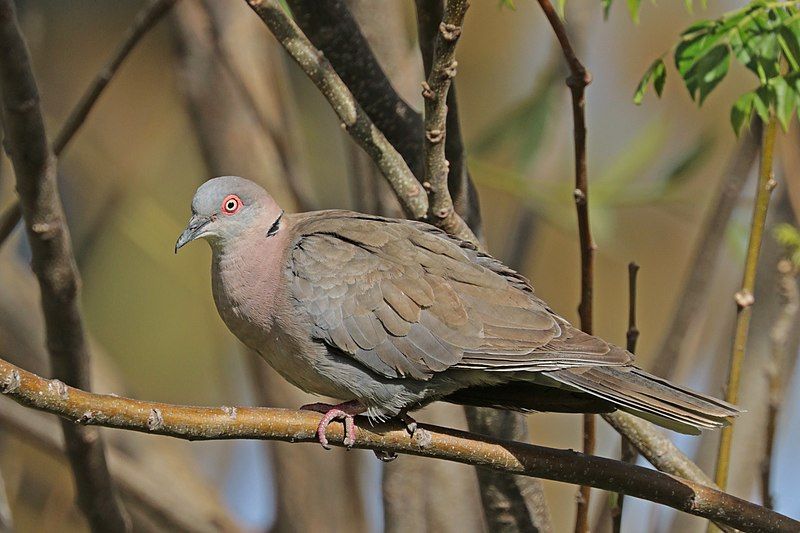
The Mourning Collared Dove, also known as the African Mourning Dove, is a dove native to Africa south of the Sahara. It is a widespread bird and is often found near water.
It is not to be confused with the North American Mourning Dove, a different species. The Mourning Collared Dove is a peaceful bird often seen in other doves’ company. It has a grayish-brown color with a distinctive black collar around its neck.
The Mourning Collared Dove feeds on grains, seeds, and other vegetation. They also feed on insects like caterpillars, beetles, and grasshoppers. The Mourning Collared Dove is a monogamous species; pairs usually breed annually.
The female builds a flimsy nest on a tree branch or bush and lays two white eggs. The chicks are usually fledged and independent within three weeks. This species is a valuable food source for many predators, including humans.
| Kingdom | Animalia |
| Phylum | Chordata |
| Class | Aves |
| Order | Columbiformes |
| Family | Columbidae |
| Genus | Streptopelia |
| Species | S. decipiens |
2. Harlequin Quail
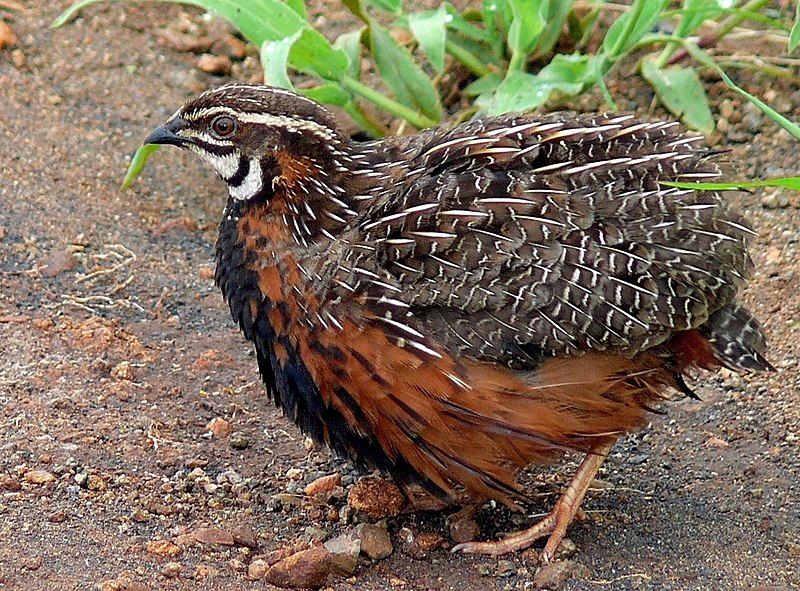
The Harlequin Quail is a species of bird in the family Phasianidae, native to sub-Saharan Africa and the Arabian Peninsula. It is a small, colorful species, with males typically having a white head and chest and a brown body with black patches.
The species was first described in 1848 and was named after the collector Adolphe Delegorgue. Delegorgue was a French explorer who made several expeditions to Africa in the mid-1800s and was one of the first Europeans to observe the Harlequin Quail.
He collected specimens of the species and described them in his accounts of his travels. The Harlequin Quail is still found in its native range but is listed as near threatened due to habitat loss and hunting.
It is an important food source for many people in its range, and its meat is highly prized.
| Kingdom | Animalia |
| Phylum | Chordata |
| Class | Aves |
| Order | Galliformes |
| Family | Phasianidae |
| Genus | Coturnix |
| Species | C. delegorguei |
3. Chestnut-Bellied Sandgrouse
The chestnut-bellied sandgrouse, also known as the common sandgrouse, is a species of bird found in various parts of the world. It is a sedentary species, meaning it does not migrate and stays within its range all year round.
The range of this species stretches from northern and central Africa to western and southern Asia. The chestnut-bellied sandgrouse has six subspecies, each with its unique characteristics.
For example, one subspecies, known as the Arabian sandgrouse, is found in the deserts of the Middle East. In contrast, another subspecies, known as the black-throated sandgrouse, is found in the dry regions of central Africa.
The chestnut-bellied sandgrouse is an omnivore and feeds on various tiny seeds, insects, and other plants. It also uses its long bill to dig out food from the soil.
This species is known to form large flocks of up to several hundred individuals and may even join up with other sandgrouse species to forage together.
The chestnut-bellied sandgrouse is an essential species for the health of these ecosystems, as it helps spread seeds and improve soil fertility.
| Kingdom | Animalia |
| Phylum | Chordata |
| Class | Aves |
| Order | Pterocliformes |
| Family | Pteroclidae |
| Genus | Pterocles |
| Species | P. exustus |
4. Fiery-Necked Nightjar
The Fiery-necked Nightjar is a unique bird species found in the southern regions of Africa. It belongs to the Caprimulgidae family and has a distinctive call that is often heard.
This call is usually rendered as “good-lord-deliver-us.”The Fiery-necked Nightjar is a medium-sized bird with a blackish-brown body and a distinctive bright, orange-red neck and throat. It has a short, rounded tail and blackish wings with white spots.
Its call is loud and distinctive, often heard in the evening and at night.
Its call is a mixture of harsh and whistling notes, ending with a rising inflection. The Fiery-necked Nightjar is an insect-eating bird that feeds mainly on moths, beetles, crickets, and other small insects. It has been known to feed on tiny frogs, lizards, and snakes.
During the breeding season, the male Fiery-necked Nightjar will perch on a branch and sing its distinctive call to attract a mate. The Fiery-necked Nightjar is an elusive and shy bird rarely seen during the day.
It prefers to be active at night and is often heard rather than seen. Its distinctive call, “good-lord-deliver-us,” is a reminder of the bird’s presence in Africa’s southern regions.
| Kingdom | Animalia |
| Phylum | Chordata |
| Class | Aves |
| Clade | Strisores |
| Order | Caprimulgiformes |
| Family | Caprimulgidae |
| Genus | Caprimulgus |
| Species | C. pectoralis |
5. White-Browed Coucal
The white-browed coucal, also known as the lark-heeled cuckoo, is a species of cuckoo found in sub-Saharan Africa. It prefers habitats with thick vegetation, such as undergrowth and scrub, and can also be found in coastal regions.
It is sometimes classified as a subspecies of Burchell’s coucal. This species has a distinct white eyebrow, distinguishing it from other cuckoo species. The white-browed coucal is an omnivorous bird, feeding on both insects and small vertebrates.
They are also known to eat berries, fruits, and seeds. They typically nest on the ground or in low shrubs, creating a cup-like nest. They are also highly vocal and usually call during the day.
The white-browed coucal is an important species as it serves as a food source for larger birds and helps disperse seeds, aiding in vegetation regeneration.
| Kingdom | Animalia |
| Phylum | Chordata |
| Class | Aves |
| Order | Cuculiformes |
| Family | Cuculidae |
| Genus | Centropus |
| Species | C. superciliosus |
6. Greater Flamingo
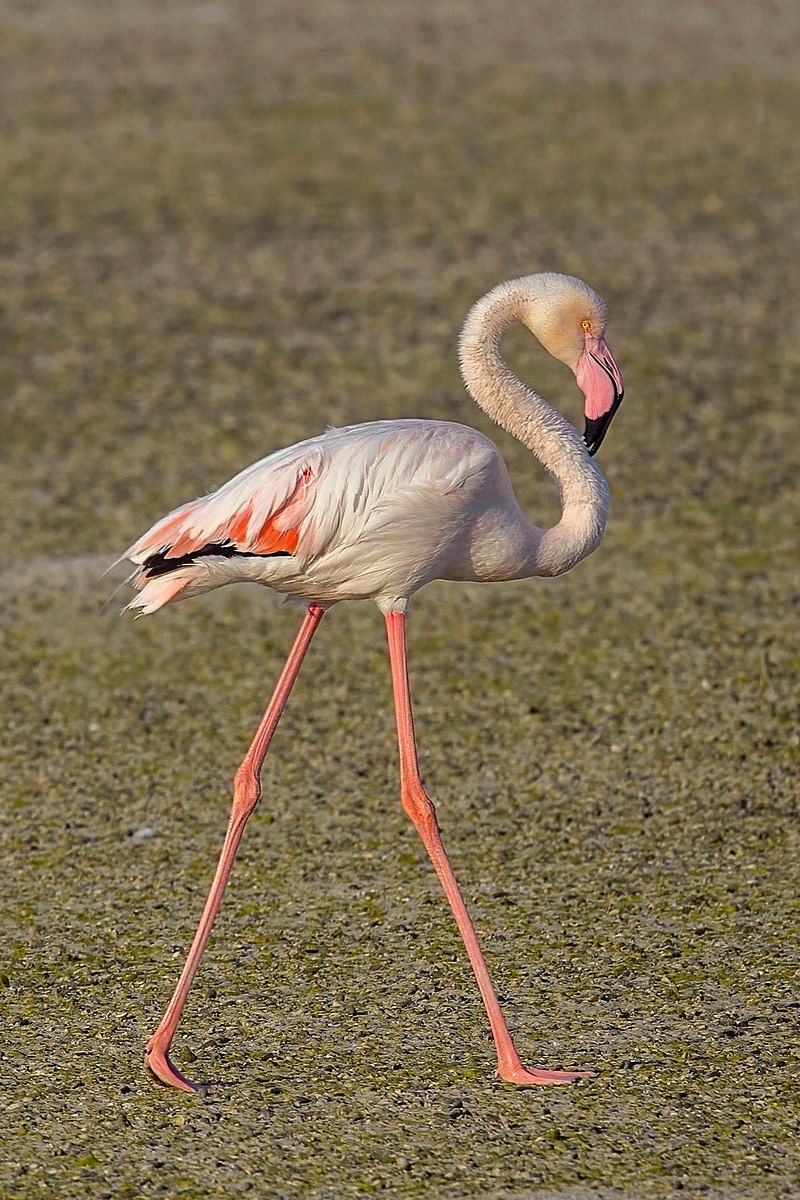
The greater flamingo is the most widely distributed and most prominent species of flamingo.
They can be found in several areas in the Old World, such as Northern and Sub-Saharan Africa, the Indian Subcontinent, the Middle East, the Levant, the Persian Gulf, the Gulf of Aden, the Red Sea, and the Mediterranean countries of Southern Europe.
These areas provide a variety of habitats for the greater flamingo, from wetlands and freshwater lakes to saltwater lagoons and coastal regions. The greater flamingo is an incredibly adaptable species that can find suitable habitats in various climates and regions.
The greater flamingo is a large, impressive bird with a wingspan reaching up to 2 meters. They have curved bills and long necks colored bright pink and white, with a yellow or orange patch on their head.
They are also recognizable for their long legs and large feet, which allow them to wade through shallow waters to feed on small aquatic animals and algae. The greater flamingo is a social species that lives in large colonies of up to several thousand birds.
They are monogamous and nest in shallow water, laying one or two eggs, which both parents incubate. The chicks are fed a specialized secretion from the adult’s bill called “crop milk,” which is rich in proteins and fats.
As they mature, they become more independent and disperse to form their colonies. The greater flamingo is an essential species in the Old World, and their presence in a location often indicates a healthy, well-balanced ecosystem.
They are essential for local communities, providing jobs through tourism and ornamental trades. Additionally, they serve as an important indicator species, signaling environmental changes that may be detrimental to other species.
| Kingdom | Animalia |
| Phylum | Chordata |
| Class | Aves |
| Order | Phoenicopteriformes |
| Family | Phoenicopteridae |
| Genus | Phoenicopterus |
| Species | P. roseus |
7. White-Tailed Tropicbird
The white-tailed tropicbird is a species of seabird found in tropical oceans worldwide. It is the smallest of three closely related species and the smallest member of the order Phaethontiformes.
This bird is mainly found in the tropical Atlantic, western Pacific, and Indian Oceans. It has a white body with a distinctive long tail and a yellow crest on its head. Its wings are long and pointed, and the wingspan is usually around 1.2 to 1.5 meters.
The white-tailed tropicbird mainly feeds on fish and crustaceans, which it finds in the ocean. It is a strong flier and can reach up to 90 kilometers per hour. It usually nests on cliffs or isolated islands and lays two to three eggs in its nest.
The white-tailed tropicbird is a prominent species often seen flying high above the ocean. It symbolizes the tropical ocean and is integral to the local ecosystem.
| Kingdom | Animalia |
| Phylum | Chordata |
| Class | Aves |
| Order | Phaethontiformes |
| Family | Phaethontidae |
| Genus | Phaethon |
| Species | P. lepturus |
8. Crested Francolin
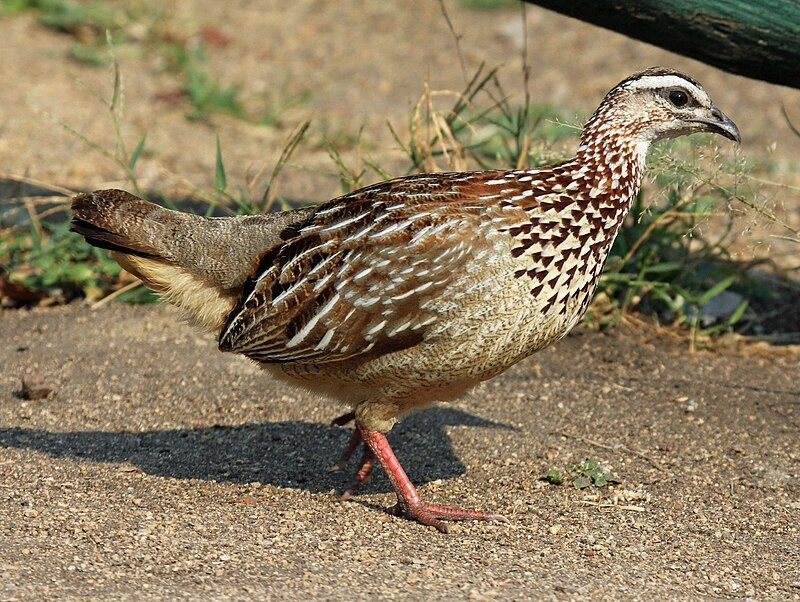
The crested francolin is a species of bird in the family Phasianidae. It is native to southern Africa and is found in various habitats, from grasslands to woodlands.
One of the crested francolin’s subspecies, the Ortygornis sephaena ovum, has been the subject of much debate in the scientific community. Some believe it is a separate species and have referred to it as Kirk’s francolin.
This species is characterized by its brownish-grey coloration, darker feathers on the back and wings, and white-barred flanks. It has a distinctive crest on its head, which is usually a pale yellowish-brown color with a dark-brown line running through it.
The crested francolin is a vocal species with a loud, repetitive call. It is also an omnivore, feeding on various seeds, insects, and plant material.
| Kingdom | Animalia |
| Phylum | Chordata |
| Class | Aves |
| Order | Galliformes |
| Family | Phasianidae |
| Genus | Ortygornis |
| Species | O. sephaena |
9. Namaqua Dove
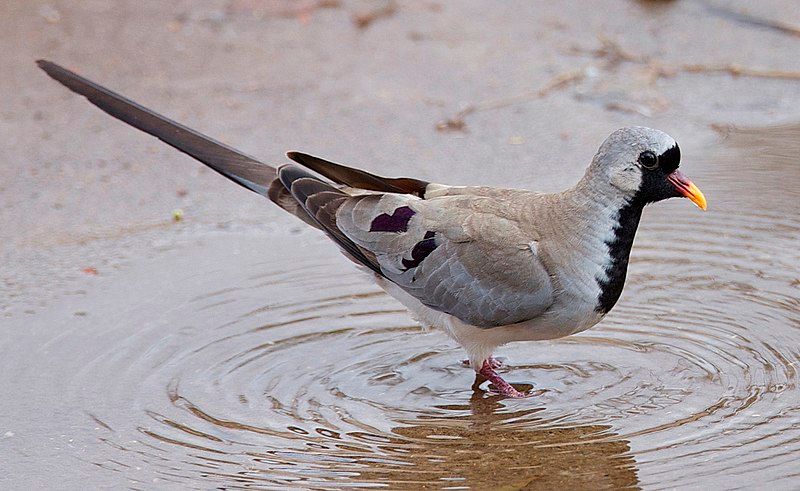
The Namaqua dove is a small bird from the pigeon family found all over Sub-Saharan Africa, Arabia, and Madagascar. It is the only species in the genus Oena, which indicates its uniqueness.
Its medium-sized body, grey plumage, and pinkish legs and feet quickly identify it. Its head is usually a darker grey than the rest of its body and has a white stripe along its neck. The Namaqua dove is a ground-dwelling species that prefers an arid climate.
It feeds mainly on seeds found on the ground and has a unique adaptation where it can store excess food in its crop, a pouch located in its neck.
It is a social species often seen in small groups or pairs. The Namaqua dove is a widespread species for birdwatchers and is a reasonably common sight in many parts of Africa.
It is a hardy species and has adapted well to human activity, making it an excellent species for birders to observe.
| Kingdom | Animalia |
| Phylum | Chordata |
| Class | Aves |
| Order | Columbiformes |
| Family | Columbidae |
| Genus | Oena |
| Species | O. capensis |
10. Pennant-Winged Nightjar
The pennant-winged nightjar is a species found from Nigeria to northern South Africa. It is an intra-African migrant, meaning it migrates within the continent, traveling from one region to another.
During the breeding season, this nightjar species displays remarkable sexual dimorphism, which is the difference between the males and females of the same species.
Male pennant-winged nightjars have black feathers with white spots and a long tail with white stripes on the underside. Females, on the other hand, are usually dull brown with white-spotted wings.
This nightjar species is nocturnal and can be found in dry, open woodlands, grasslands, and savannahs. They feed on insects they catch in flight and roost during the day.
The pennant-winged nightjar is an essential species and an integral part of the African ecosystem.
| Kingdom | Animalia |
| Phylum | Chordata |
| Class | Aves |
| Clade | Strisores |
| Order | Caprimulgiformes |
| Family | Caprimulgidae |
| Genus | Caprimulgus |
| Species | C. vexillarius |
11. Yellow-Necked Spurfowl
The yellow-necked spurfowl, also known as the yellow-necked francolin, is a species of bird belonging to the family Phasianidae. This species can be found in the East African countries of Djibouti, Eritrea, Ethiopia, Kenya, Somalia, Sudan, Tanzania, and Uganda.
It is easily identifiable by the bright yellow patch of feathers on its neck, which gives the bird its name. The yellow-necked spurfowl is a medium-sized bird with a gray-brown body and a speckled neck and throat. Its wings and tail are blackish-gray with a few white patches.
Its bill is yellow, and its eyes are dark brown. Although the bird is primarily monogamous, it has occasionally formed small flocks. The yellow-necked spurfowl usually inhabits dry, open areas such as grasslands, scrublands, and savannas.
Its diet consists primarily of seeds, fruits, and insects. It is an active foraging bird and can often be seen scratching the ground for food. The yellow-necked spurfowl is an essential species in the region, providing food for local communities.
It is also essential to the local ecosystem, dispersing seeds and controlling insect populations. Unfortunately, this species is threatened by habitat loss and hunting. Conservation efforts are therefore necessary to ensure its survival.
| Kingdom | Animalia |
| Phylum | Chordata |
| Class | Aves |
| Order | Galliformes |
| Family | Phasianidae |
| Genus | Pternistis |
| Species | P. leucoscepus |
12. Slender-Tailed Nightjar
The slender-tailed nightjar is a species of bird in the family Caprimulgidae, which includes birds known for their nocturnal habits and mottled, camouflaged plumage.
This nightjar species is found in several African countries, including the Democratic Republic of the Congo, Ethiopia, Kenya, Somalia, South Sudan, Tanzania, and Uganda. It has a slender tail and a tiny body, which makes it a difficult bird to spot.
The slender-tailed nightjar is primarily active at night when it can be seen foraging for insects and other small prey, an activity that gives it its name. Its mottled feathers help it blend in with its surroundings, making it harder for predators to spot.
The slender-tailed nightjar is an integral part of the African ecosystem, as it helps control insect populations and is a food source for other animals.
| Kingdom | Animalia |
| Phylum | Chordata |
| Class | Aves |
| Clade | Strisores |
| Order | Caprimulgiformes |
| Family | Caprimulgidae |
| Genus | Caprimulgus |
| Species | C. clarus |
Conclusion
Birds in Shinyanga play an essential role in the local ecosystem. They provide food for other animals, help disperse seeds and pollen, and provide natural pest control.
Additionally, they provide enjoyment for bird watchers and add beauty to the landscape. With the help of conservation efforts, the bird population of Shinyanga will continue to thrive and benefit the local environment.